An Introduction to Bioinformatics Algorithms www bioalgorithms info

An Introduction to Bioinformatics Algorithms www. bioalgorithms. info Molecular Evolution and Reconstruction of Evolutionary Trees

An Introduction to Bioinformatics Algorithms Outline • • • • Evolutionary/Phylogenetic Tree Reconstruction “Out of Africa” hypothesis Did we evolve from Neanderthals? Distance Based Phylogeny Neighbor Joining Algorithm Additive Phylogeny Least Squares Distance Phylogeny UPGMA Character Based Phylogeny Small Parsimony Problem Fitch and Sankoff Algorithms Large Parsimony Problem Maximum Likelihood Method Evolution of Wings HIV Evolution of Human Repeats www. bioalgorithms. info

An Introduction to Bioinformatics Algorithms www. bioalgorithms. info (Early) Evolutionary Studies • Anatomical features were the dominant criteria used to derive evolutionary relationships between species since Darwin till early 1960 s • The evolutionary relationships derived from these relatively subjective observations were often inconclusive. Some of them were later proved incorrect (Left) 47 million year old primate fossil found 5/17/09. (Right) 3. 8 million year old human ancestor skull reported 8/28/19 Legless lizards have ear opening and movable eyelids 9/20/13

An Introduction to Bioinformatics Algorithms www. bioalgorithms. info Evolution and DNA Sequence Analysis: the Giant Panda Riddle • For roughly 100 years scientists were unable to figure out which family the giant panda belongs to • Giant pandas look like bears but have features that are unusual for bears and typical for raccoons, e. g. , they do not hibernate • In 1985, Steven O’Brien and colleagues solved the giant panda classification problem using DNA sequences and algorithms

An Introduction to Bioinformatics Algorithms www. bioalgorithms. info Evolutionary Tree of Bears and Raccoons

An Introduction to Bioinformatics Algorithms www. bioalgorithms. info Out of Africa Hypothesis • Around the time the giant panda riddle was solved, a DNA-based reconstruction of the human evolutionary tree led to the Out of Africa Hypothesis that claims our most ancient ancestor lived in Africa roughly 150, 000 years ago

An Introduction to Bioinformatics Algorithms www. bioalgorithms. info Human Evolutionary Tree (cont’d) http: //www. mun. ca/biology/scarr/Out_of_Africa 2. htm

An Introduction to Bioinformatics Algorithms www. bioalgorithms. info The Origin of Humans: ”Out of Africa” vs Multiregional Hypothesis Out of Africa: • Humans evolved in Africa ~150, 000 years ago • Humans migrated out of Africa, replacing other humanoids around the globe • There is no direct descendence from Neanderthals Multiregional: • Humans migrated out of Africa mixing with other humanoids on the way • There is a genetic continuity from Neanderthals to humans • Humans evolved in the last two million years as a single species. Independent appearance of modern traits in different areas

An Introduction to Bioinformatics Algorithms www. bioalgorithms. info mt. DNA Analysis Supports the “Out of Africa” Hypothesis African origin of humans inferred from: • African population was the most diverse (sub-populations had more time to diverge) • The evolutionary tree separated one group of Africans from a group containing all five populations • Tree was rooted on branch between groups of greatest difference

An Introduction to Bioinformatics Algorithms www. bioalgorithms. info Evolutionary Tree of Humans (mt. DNA) The evolutionary tree separates one group of Africans from a group containing populations from all five continents Vigilant, Stoneking, Harpending, Hawkes, and Wilson (1991)

An Introduction to Bioinformatics Algorithms www. bioalgorithms. info Evolutionary Tree of Humans: (Microsatellites) Neighbor joining tree for 14 human populations genotyped with 30 microsatellite loci

An Introduction to Bioinformatics Algorithms www. bioalgorithms. info Human Migration Out of Africa 1. Yorubans 2. Western Pygmies 3. Eastern Pygmies 4. Hadza 5. !Kung 1 2 3 4 5 http: //www. becominghuman. org

An Introduction to Bioinformatics Algorithms www. bioalgorithms. info Two Neanderthal Discoveries Feldhofer, Germany Mezmaiskaya, Caucasus Distance: 2500 km

An Introduction to Bioinformatics Algorithms www. bioalgorithms. info Two Neanderthal Discoveries • Is there a connection between Neanderthals and today’s Europeans? • If humans did not evolve from Neanderthals, whom did we evolve from?

An Introduction to Bioinformatics Algorithms www. bioalgorithms. info Multiregional Hypothesis? • May predict some genetic continuity from the Neanderthals through to the Cro-Magnons (i. e. , anatomically modern humans or AMHs) up to today’s Europeans • Can explain the occurrence of varying regional characteristics

An Introduction to Bioinformatics Algorithms www. bioalgorithms. info Sequencing Neanderthal’s mt. DNA • mt. DNA from the bone of Neanderthal is used because it is up to 1, 000 x more abundant than nuclear DNA • DNA decay overtime and only a small amount of ancient DNA can be recovered (upper limit: 100, 000 years) • PCR of mt. DNA (fragments are too short, human DNA may be mixed in)

An Introduction to Bioinformatics Algorithms www. bioalgorithms. info Neanderthals vs Humans: Surprisingly large divergence • AMH vs Neanderthal: • 22 substitutions and 6 indels in a 357 bp region • AMH vs AMH • only 8 substitutions • However, a draft Neanderthal genome was sequenced in 2010, suggesting 1% - 4% contribution to non-African human genomes and some evidence of interbreeding

An Introduction to Bioinformatics Algorithms www. bioalgorithms. info Evolutionary Trees How are these trees built from DNA sequences?

An Introduction to Bioinformatics Algorithms www. bioalgorithms. info Evolutionary Trees (or Phylogenetic Trees or Phylogenies) How are these trees built from DNA sequences? In an evolutionary tree, • leaves represent existing species (or taxa) • internal vertices represent ancestors (and speciation events) • root represents the oldest evolutionary ancestor • edges (and subtrees under them) are sometimes called lineages

An Introduction to Bioinformatics Algorithms www. bioalgorithms. info Rooted and Unrooted Trees In an unrooted tree, the position of the root (“oldest ancestor”) is unknown. Otherwise, they are like rooted trees. We are especially interested in degree-3 (unrooted) trees because they correspond to binary phyolegenies.

An Introduction to Bioinformatics Algorithms www. bioalgorithms. info Distances in Trees • Edges may have weights reflecting: • Number of mutations in the evolutionary process from one species to another • Time estimate for evolution from one species into another • In a tree T, we often compute dij(T) - the length of the path between leaves i and j dij(T) is called the tree distance between i and j

An Introduction to Bioinformatics Algorithms www. bioalgorithms. info Distance in Trees: an Example j i d 1, 4 = 12 + 13 + 14 + 17 + 12 = 68

An Introduction to Bioinformatics Algorithms www. bioalgorithms. info Distance Matrix • Given n species, we can compute an n x n distance matrix D • Dij may be defined as the (weighted) edit distance between the same gene in species i and j, where the gene of interest is sequenced for all n species Dij – edit distance between i and j (min number of edit operations to transform one sequence into the other) An alignment displays how to edit one sequence into the other using operations insertion, deletion, and substitutions. The largest score implies the smallest editing cost. So, the (weighted) edit distance basically complements the optimal alignment score, and can thus be viewed as the alignment cost. ACTGGA T AGT GACT

An Introduction to Bioinformatics Algorithms www. bioalgorithms. info Edit Distance vs. Tree Distance • Given n species, we can compute the n x n distance matrix D • Dij may be defined as the edit distance between the same gene in species i and species j, where the gene of interest is sequenced for all n species Dij – edit distance between i and j • Note the difference from dij(T) – tree distance between i and j

An Introduction to Bioinformatics Algorithms www. bioalgorithms. info Fitting Distance Matrix • Given n species, we can compute the n x n distance matrix D • Evolution of these genes is described by a tree that we don’t know • We need an algorithm to construct a tree that best fits the distance matrix D

An Introduction to Bioinformatics Algorithms www. bioalgorithms. info Fitting Distance Matrix Length of path in an (unknown) tree T • Fitting means Dij = dij(T) Edit distance between species (known)

An Introduction to Bioinformatics Algorithms www. bioalgorithms. info Reconstructing a 3 Leaved Tree • Tree reconstruction for any 3 x 3 matrix is straightforward • We have 3 leaves i, j, k and a center vertex c Observe: dic + djc = Dij dic + dkc = Dik djc + dkc = Djk

An Introduction to Bioinformatics Algorithms www. bioalgorithms. info Reconstructing a 3 Leaved Tree (cont’d) dic + djc = Dij + dic + dkc = Dik 2 dic + djc + dkc = Dij + Dik 2 dic + Djk = Dij + Dik dic = (Dij + Dik – Djk)/2 Similarly, djc = (Dij + Djk – Dik)/2 dkc = (Dki + Dkj – Dij)/2

An Introduction to Bioinformatics Algorithms www. bioalgorithms. info Trees with > 3 Leaves • A degree-3 tree with n leaves has 2 n-3 edges • This means fitting a given tree to a distance matrix D requires solving a system of “n choose 2” equations with 2 n-3 variables • This is not always possible to solve for n > 3

An Introduction to Bioinformatics Algorithms www. bioalgorithms. info Additive Distance Matrices Matrix D is ADDITIVE if there exists a tree T with dij(T) = Dij NON-ADDITIVE otherwise

An Introduction to Bioinformatics Algorithms www. bioalgorithms. info Distance Based Phylogenetic Reconstruction • Goal: Reconstruct an evolutionary tree from a distance matrix • Input: n x n distance matrix D • Output: weighted tree T with n leaves fitting D • If D is additive, this problem has a solution and there is a simple algorithm to solve it

An Introduction to Bioinformatics Algorithms www. bioalgorithms. info Using Neighboring Leaves to Construct the Tree • Find neighboring leaves i and j with parent k • Remove the rows and columns of i and j • Add a new row and column corresponding to k, where the distance from k to any other leaf m can be computed as: Dkm = (Dim + Djm – Dij)/2 Compress i and j into k, and iterate algorithm for rest of tree

An Introduction to Bioinformatics Algorithms www. bioalgorithms. info Finding Neighboring Leaves • To find neighboring leaves we could simply select a pair of closest leaves.

An Introduction to Bioinformatics Algorithms www. bioalgorithms. info Finding Neighboring Leaves • To find neighboring leaves we could simply select a pair of closest leaves. WRONG

An Introduction to Bioinformatics Algorithms www. bioalgorithms. info Finding Neighboring Leaves • Closest leaves aren’t necessarily neighbors • i and j are neighbors, but (dij = 13) > (djk = 12) • Finding a pair of neighboring leaves is a nontrivial problem!

An Introduction to Bioinformatics Algorithms www. bioalgorithms. info Neighbor Joining Algorithm • In 1987, Naruya Saitou and Masatoshi Nei developed a neighbor joining algorithm (NJ) for phylogenetic tree reconstruction • Finds a pair of leaves that are close to each other but far from the other leaves: implicitly finds a pair of neighboring leaves • Advantage: works well for additive and other non-additive matrices, it does not have the flawed molecular clock assumption • More details in the old slides

An Introduction to Bioinformatics Algorithms www. bioalgorithms. info Degenerate Triples • A degenerate triple is a set of three distinct species/taxa 1≤i, j, k≤n where Dij + Djk = Dik • Species j in a degenerate triple i, j, k lies on the evolutionary path from species i to species k (or is attached to this path by an edge of length 0)

An Introduction to Bioinformatics Algorithms www. bioalgorithms. info Looking for Degenerate Triples • If distance matrix D has a degenerate triple i, j, k then j can be “removed” from D thus reducing the size of the problem • If distance matrix D does not have a degenerate triple i, j, k, one can “create” a degenerative triple in D by shortening all hanging edges (in the tree)

An Introduction to Bioinformatics Algorithms www. bioalgorithms. info Shortening Hanging Edges to Produce Degenerate Triples • Shorten all “hanging” edges (edges that connect leaves) until a degenerate triple is found

An Introduction to Bioinformatics Algorithms www. bioalgorithms. info Finding Degenerate Triples • If there is no degenerate triple, all hanging edges are reduced by the same amount δ, so that all pair-wise distances in the matrix are reduced by 2δ. • Eventually this process collapses one of the leaves (when δ = length of shortest hanging edge), forming a degenerate triple i, j, k and reducing the size of the distance matrix D. • The attachment point for j can be recovered in the reverse transformations by saving Dij for each collapsed leaf.

An Introduction to Bioinformatics Algorithms www. bioalgorithms. info Reconstructing Trees for Additive Distance Matrices

An Introduction to Bioinformatics Algorithms www. bioalgorithms. info Additive Phylogeny Algorithm 1. Additive. Phylogeny(D) 2. if D is a 2 x 2 matrix 3. T = tree of a single edge of length D 1, 2 4. return T 5. if D is non-degenerate 6. δ = trimming parameter of matrix D 7. for all 1 ≤ i ≠ j ≤ n 8. Dij = Dij - 2δ 9. else 10. δ=0

An Introduction to Bioinformatics Algorithms www. bioalgorithms. info Additive. Phylogeny (cont’d) 1. 2. 3. 4. 5. 6. 7. 8. 9. 10. 11. 12. Find a triple i, j, k in D such that Dij + Djk = Dik x = Dij Remove jth row and jth column from D T = Additive. Phylogeny(D) Add a new vertex v to T at distance x on the path from i to k Add j back to T by creating an edge (v, j) of length 0 for every leaf l in T if distance from l to j in the tree ≠ Dl, j output “matrix is not additive” return Extend all “hanging” edges by length δ return T

An Introduction to Bioinformatics Algorithms www. bioalgorithms. info The Four Point Condition • Additive. Phylogeny provides a way to check if distance matrix D is additive • An even more efficient additivity check is the “four-point condition” • Let 1 ≤ i, j, k, l ≤ n be four distinct leaves in some (unknown) tree. This quartet induces an (unknown) 4 -leaf tree (or 4 -tree) where the neighboring pairs are, e. g. , i, j and k, l

An Introduction to Bioinformatics Algorithms www. bioalgorithms. info The Four Point Condition (cont’d) Compute: 1. Dij + Dkl, 2. Dik + Djl, 3. Dil + Djk 2 3 1 2 and 3 represent the same number: the length of all edges with 2 X the middle edge 1 represents a smaller number: the length of all edges – the middle edge

An Introduction to Bioinformatics Algorithms www. bioalgorithms. info The Four Point Condition: Theorem • The four point condition for the quartet i, j, k, l is satisfied if two of these sums are the same, with the third sum smaller than the first two • Theorem (Buneman): An n x n matrix D is additive if and only if the four point condition holds for every quartet 1 ≤ i, j, k, l ≤ n • Proof in old slides

An Introduction to Bioinformatics Algorithms www. bioalgorithms. info Tree reconstruction based on Buneman’s Theorem Consider leaves 1, 2, 3, 4. If then their quartet tree is: 2 1 A 3 5 B 5 5 5 4 Now we insert leaf 5 into the tree, and consider quartet 1, 2, 3, 5. If then we insert leaf 5 between ancestor A and leaf 3. But If then leaf 5 could be inserted either between A and B or between B and 2 or between B and 4. So, we need to further consider a quartet 1, 2, 4, 5 and decide the precise edge to insert 5.

An Introduction to Bioinformatics Algorithms www. bioalgorithms. info Least Squares Distance Phylogeny Problem • If the distance matrix D is NOT additive, then we look for a tree T that approximates D the best: Squared Error : ∑i, j (dij(T) – Dij)2 • Squared Error is a measure of the quality of fit between the distance matrix and the tree: we want to minimize it. • Least Squares Distance Phylogeny Problem: Finding the best approximate tree T for a given non-additive matrix D (which is NP-hard). • In practice, heuristic algorithms like NJ are used.

An Introduction to Bioinformatics Algorithms www. bioalgorithms. info UPGMA: Unweighted Pair Group Method with Arithmetic Mean • UPGMA is a hierarchical clustering algorithm that: • computes the distance between clusters using average pairwise distance (avg link) • assigns a height to every vertex in the tree, effectively assuming the presence of a molecular clock and thus dating every vertex

An Introduction to Bioinformatics Algorithms www. bioalgorithms. info Clustering in UPGMA Given two disjoint clusters Ci, Cj of sequences, 1 dij = ––––– {p Ci, q Cj}dpq |Ci| |Cj| Note that if Ck = Ci Cj, then distance to another cluster Cl is: dil |Ci| + djl |Cj| dkl = ––––––– |Ci| + |Cj|

An Introduction to Bioinformatics Algorithms www. bioalgorithms. info The UPGMA Algorithm Initialization: Assign each taxa xi to its own cluster Ci Define a leaf for each taxa, with height 0 Iteration: Find two clusters Ci and Cj such that dij is the minimum Let Ck = Ci Cj Add a vertex connecting Ci, Cj and place it at height dij /2 Delete Ci and Cj Termination: When a single cluster remains

An Introduction to Bioinformatics Algorithms www. bioalgorithms. info The UPGMA Algorithm (cont’d) 1 4 3 1 4 5 2 2 3 5

An Introduction to Bioinformatics Algorithms www. bioalgorithms. info UPGMA’s Weakness • The algorithm produces an ultrametric tree: the distance from the root to every leaf is the same • UPGMA assumes a constant molecular clock: all species represented by the leaves in the tree are assumed to accumulate mutations (and thus evolve) at the same rate. This is a major pitfall of UPGMA

An Introduction to Bioinformatics Algorithms www. bioalgorithms. info UPGMA’s Weakness: Example Correct tree UPGMA 3 2 4 1 1 4 2 3 This is called long branch attraction

An Introduction to Bioinformatics Algorithms www. bioalgorithms. info Alignment Matrix vs. Distance Matrix Sequence a gene of length l nucleotides (or amino acids) in n species to generate an n x m (multiple) alignment matrix CANNOT be transformed back into alignment matrix because information was lost on the forward transformation Transform into n x n distance matrix D

An Introduction to Bioinformatics Algorithms www. bioalgorithms. info Character-Based Phylogenetic Reconstruction • A potentially better technique: • Character-based reconstruction algorithms use the n x m alignment matrix (n = # species, m = #characters) directly instead of using distance matrix • GOAL: Determine a tree and the character strings at the internal nodes of the tree that would best explain the n observed character strings at the leaves (species)

An Introduction to Bioinformatics Algorithms www. bioalgorithms. info Character-Based Tree Reconstruction (cont’d) • Characters may be nucleotides, where A, G, C, T are the states of this character, or amino acids. Other characters may be the # of eyes or legs or the shape of a beak or a fin. • By setting the length of an edge in the tree to the (weighted) Hamming distance, we may define the parsimony score (actually cost) of the tree as the sum of the lengths (i. e. , weights) of the edges.

An Introduction to Bioinformatics Algorithms www. bioalgorithms. info Parsimony Approach to Evolutionary Tree Reconstruction • Applies Occam’s razor principle to identify the simplest explanation for the data • Assumes the observed character differences at the leaves resulted from the fewest possible mutations in the tree • Seeks the tree that yields lowest possible parsimony score - sum of cost of all mutations found in the tree • Suffers from long branch attraction described on slide 61 and is statistically inconsistent, but still among the most popular methods in practice

An Introduction to Bioinformatics Algorithms www. bioalgorithms. info Parsimony and Tree Reconstruction

An Introduction to Bioinformatics Algorithms www. bioalgorithms. info Character-Based Tree Reconstruction (cont’d)

An Introduction to Bioinformatics Algorithms www. bioalgorithms. info Small Parsimony Problem • Input: Tree T with each leaf labeled by an -character string. m • Output: Labeling of all internal nodes of the tree T minimizing the parsimony score (i. e. , total Hamming distance or number of mutations). • We can assume that every leaf is labeled by a single character, because the characters in the string are independent in this problem.

An Introduction to Bioinformatics Algorithms www. bioalgorithms. info Weighted Small Parsimony Problem • A more general version of the Small Parsimony Problem • Input includes a k*k scoring matrix describing the cost of transformation/mutation from each of the k states into another one • Weighted Hamming distance is used instead • For the Small Parsimony problem, the scoring matrix is based on Hamming distance d. H(v, w) = 0 if v=w d. H(v, w) = 1 otherwise • Equivalent to calculating the Tree Score of a multiple sequence alignment under a given evolutionary tree

An Introduction to Bioinformatics Algorithms www. bioalgorithms. info Scoring Matrices Small Parsimony Problem A A 0 T 1 G 1 C 1 T 1 0 1 1 G C 1 1 0 Weighted Parsimony Problem A A 0 T 3 G 4 C 9 T 3 0 2 4 G C 4 9 2 4 0 4 4 0

An Introduction to Bioinformatics Algorithms www. bioalgorithms. info Unweighted vs. Weighted Small Parsimony Scoring Matrix A A 0 T 1 G 1 C 1 T 1 0 1 1 G C 1 1 0 Small Parsimony Score: 5

An Introduction to Bioinformatics Algorithms www. bioalgorithms. info Unweighted vs. Weighted Parsimony Scoring Matrix A A 0 T 3 G 4 C 9 T 3 0 2 4 G C 4 9 2 4 0 4 4 0 Weighted Parsimony Score: 22

An Introduction to Bioinformatics Algorithms www. bioalgorithms. info Weighted Small Parsimony Problem: Formulation • Input: Tree T with each leaf labeled by a state and a k x k scoring matrix ( ij), assuming the character has k states • Output: Labeling of each internal vertex of the tree T with a state minimizing the total weighted parsimony score

An Introduction to Bioinformatics Algorithms www. bioalgorithms. info Sankoff Algorithm: Dynamic Programming • Calculate and keep track of the score for every possible label/state at each vertex • st(v) = minimum parsimony score of the subtree rooted at vertex v if v has state t • The score at each vertex is based on scores of its children: • st(parent) = mini {si( left child ) + i, t} + minj {sj( right child ) + j, t}

An Introduction to Bioinformatics Algorithms www. bioalgorithms. info Sankoff Algorithm (cont. ) • Begin at leaves: • If leaf has the state in question, score is 0 • Else, score is

An Introduction to Bioinformatics Algorithms www. bioalgorithms. info Sankoff Algorithm (cont. ) st(v) = mini {si(u) + i, t} + minj {sj(w) + j, t} sssi(u) sum i(u) sum i, i, i, AAA sum i(u) s. A(v) = 0 mini{si(u) + i, A} + minj{sj(w) + j, A} AA A 0 0 00 00 TTT 33 GG G 44 CC C 99

An Introduction to Bioinformatics Algorithms www. bioalgorithms. info Sankoff Algorithm (cont. ) st(v) = mini {si(u) + i, t} + minj{sj(w) + j, t} sum j, A sum j(w) sssj(w) j, j, A A s. A(v) = 0 mini{si(u) + i, A} + 9 min = 9 j{sj(w) + j, A} A A A 0 0 T TT 3 3 G G G 4 4 C C C 0 0 9 9

An Introduction to Bioinformatics Algorithms www. bioalgorithms. info Sankoff Algorithm (cont. ) st(v) = mini {si(u) + i, t} + minj{sj(w) + j, t} Repeat for T, G, and C

An Introduction to Bioinformatics Algorithms www. bioalgorithms. info Sankoff Algorithm (cont. ) Repeat for right subtree

An Introduction to Bioinformatics Algorithms www. bioalgorithms. info Sankoff Algorithm (cont. ) Repeat for root

An Introduction to Bioinformatics Algorithms www. bioalgorithms. info Sankoff Algorithm (cont. ) Smallest score at root is minimum weighted In this case, 9 – parsimony score so label with T

An Introduction to Bioinformatics Algorithms www. bioalgorithms. info Sankoff Algorithm: Traveling down the Tree • The scores at the root vertex have been computed by going up the tree • After the scores at root vertex are computed the Sankoff algorithm moves down the tree and assign each vertex with the optimal state (backtracing)

An Introduction to Bioinformatics Algorithms www. bioalgorithms. info Sankoff Algorithm (cont. ) 9 is derived from 7 + 2 So left child is T, and right child is T

An Introduction to Bioinformatics Algorithms www. bioalgorithms. info Sankoff Algorithm (cont. ) And the tree is thus labeled…

An Introduction to Bioinformatics Algorithms www. bioalgorithms. info Fitch’s Algorithm • Solves the Small Parsimony problem • Dynamic programming in essence • Assigns a set of states to every vertex in the tree • Each leaf has an input state • If the two children’s sets of states overlap, it’s the common set of them • If not, it’s the combined set (union) of them

An Introduction to Bioinformatics Algorithms www. bioalgorithms. info Fitch’s Algorithm (cont’d) An example: a c t a {a, c} a {t, a} c t a a {a, c} a a a {t, a} c t a a c t

An Introduction to Bioinformatics Algorithms www. bioalgorithms. info Fitch Algorithm 1) Assign a set of possible states to every vertex, traversing the tree from leaves to root • Each node’s set is either the intersection or union of its children’s sets (a leaf’s set consists of its label) • E. g. , if the node we are looking at has a left child labeled {A, C} and a right child labeled {A, T} (or {T}), the node will be given the set {A} (or {A, C, T}).

An Introduction to Bioinformatics Algorithms www. bioalgorithms. info Fitch Algorithm (cont. ) 2) Assign labels to each vertex, traversing the tree from root to leaves • Assign the root an arbitrary state from its set of states • For all other vertices, if its parent’s label is in its set of states, assign it its parent’s label • Else, choose an arbitrary state from its set as its label

An Introduction to Bioinformatics Algorithms www. bioalgorithms. info Fitch Algorithm (example)

An Introduction to Bioinformatics Algorithms www. bioalgorithms. info Fitch vs. Sankoff • Both have an O(nk) running time • Are they actually different? • Let’s compare …

An Introduction to Bioinformatics Algorithms Fitch As seen previously: www. bioalgorithms. info

An Introduction to Bioinformatics Algorithms www. bioalgorithms. info Comparison of Fitch and Sankoff • As seen earlier, the scoring matrix for the Fitch algorithm is merely: A T G C A 0 1 1 1 T 1 0 1 1 G 1 1 0 1 C 1 1 1 0 • So let’s do the same problem using Sankoff algorithm and this scoring matrix

An Introduction to Bioinformatics Algorithms Sankoff www. bioalgorithms. info

An Introduction to Bioinformatics Algorithms www. bioalgorithms. info Sankoff vs. Fitch • The Sankoff algorithm gives the same set of optimal labels as the Fitch algorithm • For Sankoff algorithm, letter t is optimal for vertex v if st(v) = min 1<i<ksi(v) • Denote the set of optimal letters at vertex v as S(v) • If S(left child) and S(right child) overlap, S(parent) is the intersection • Else it’s the union of S(left child) and S(right child) • This is also the Fitch recurrence • The two algorithms are identical

An Introduction to Bioinformatics Algorithms www. bioalgorithms. info The Large Parsimony Problem (i. e. , parsimony approach to phylogenetic reconstruction) • Input: An n x m matrix M describing n species, each represented by an m-character string • Output: A tree T with n leaves labeled by the n rows of matrix M, and a labeling of the internal vertices such that the parsimony score is minimized over all possible trees and all possible labelings of the internal vertices

An Introduction to Bioinformatics Algorithms www. bioalgorithms. info Large Parsimony Problem (cont. ) • Possible search space is huge, especially as n increases • (2 n – 3)!! possible rooted trees • (2 n – 5)!! possible unrooted trees • Problem is NP-hard • Exhaustive search only possible for small n (< 10) • Branch-and-bound or heuristics are often used • A variant is the Perfect Phylogeny problem as described in the old slides

An Introduction to Bioinformatics Algorithms www. bioalgorithms. info Nearest Neighbor Interchange: A greedy algorithm • A typical local search algorithm • Only evaluates a subset of all possible trees • Defines a neighbor of a tree as one reachable by a nearest neighbor interchange (or NNI) operation • A rearrangement of the four subtrees connected by each internal edge • Only three different rearrangements per edge

An Introduction to Bioinformatics Algorithms www. bioalgorithms. info Nearest Neighbor Interchange (cont. )

An Introduction to Bioinformatics Algorithms www. bioalgorithms. info Nearest Neighbor Interchange (cont. ) • Start with an arbitrary (random) tree and check its neighbors • Move to a neighbor if it provides the best improvement in the parsimony score • No way of knowing if the result is the most parsimonious tree • Could be stuck in local optimum (like other hill climbing algorithms) • Could be employed in more sophisticated local search algorithms like simulated annealing

An Introduction to Bioinformatics Algorithms www. bioalgorithms. info Subtree Pruning and Regrafting (or Subtree-Transfer): Another branch swapping algorithm http: //artedi. ebc. uu. se/course/Bio. Info-10 p-2001/Phylogeny-Tree. Search/SPR. gif

An Introduction to Bioinformatics Algorithms www. bioalgorithms. info Tree Bisection and Reconnection: Yet another branch swapping algorithm w. Most extensive swapping routine

An Introduction to Bioinformatics Algorithms www. bioalgorithms. info

An Introduction to Bioinformatics Algorithms www. bioalgorithms. info A Nucleotide Substitution Model • • Assume same rates for A B and B A Assume all mutations equally likely: Rate α The Jukes-Cantor (JC) model is given below Another popular (more general) model is Kimura 2 -parameter (K 2 P) A C G T A -3α α C α -3α α α G α α -3α α T α α α -3α

An Introduction to Bioinformatics Algorithms www. bioalgorithms. info

An Introduction to Bioinformatics Algorithms www. bioalgorithms. info

An Introduction to Bioinformatics Algorithms www. bioalgorithms. info

An Introduction to Bioinformatics Algorithms www. bioalgorithms. info

An Introduction to Bioinformatics Algorithms www. bioalgorithms. info

An Introduction to Bioinformatics Algorithms www. bioalgorithms. info

An Introduction to Bioinformatics Algorithms www. bioalgorithms. info

An Introduction to Bioinformatics Algorithms www. bioalgorithms. info
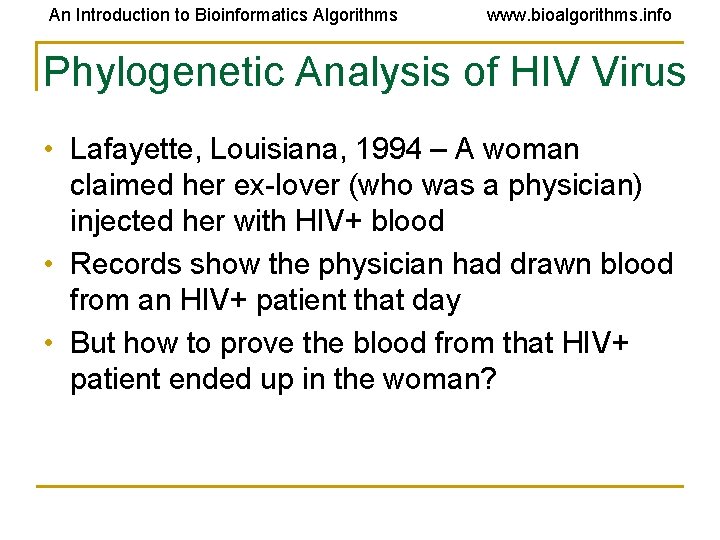
An Introduction to Bioinformatics Algorithms www. bioalgorithms. info Phylogenetic Analysis of HIV Virus • Lafayette, Louisiana, 1994 – A woman claimed her ex-lover (who was a physician) injected her with HIV+ blood • Records show the physician had drawn blood from an HIV+ patient that day • But how to prove the blood from that HIV+ patient ended up in the woman?
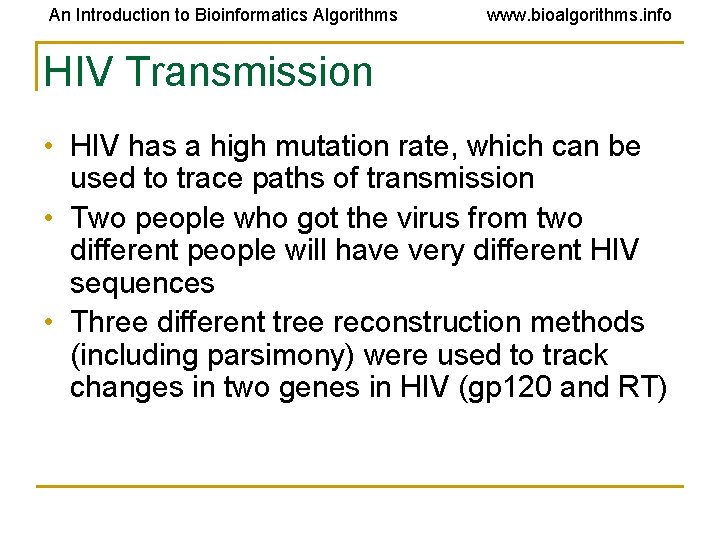
An Introduction to Bioinformatics Algorithms www. bioalgorithms. info HIV Transmission • HIV has a high mutation rate, which can be used to trace paths of transmission • Two people who got the virus from two different people will have very different HIV sequences • Three different tree reconstruction methods (including parsimony) were used to track changes in two genes in HIV (gp 120 and RT)

An Introduction to Bioinformatics Algorithms www. bioalgorithms. info HIV Transmission • Took multiple samples from the patient, the woman, and controls (non-related HIV+ people) • In every reconstruction, the woman’s sequences were found to be evolved from the patient’s sequences, indicating a close relationship between the two • Nesting of the victim’s sequences within the patient sequence indicated the direction of transmission was from patient to victim • This was the first time phylogenetic analysis was used in a court case as evidence (Metzker, et. al. , 2002)
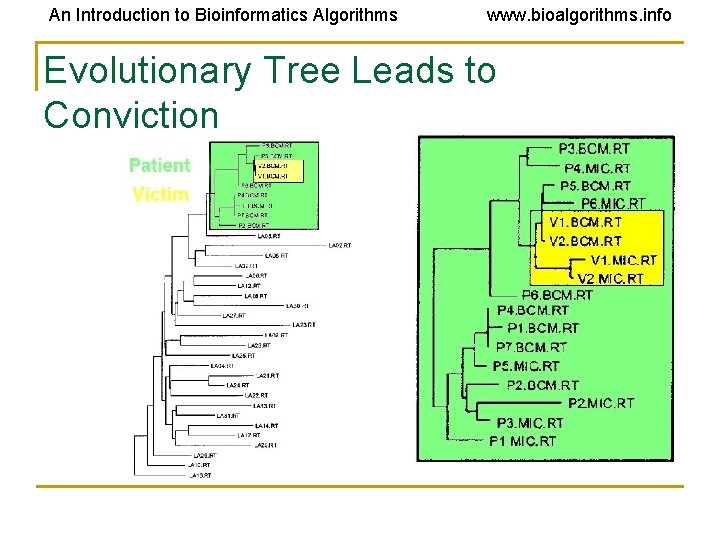
An Introduction to Bioinformatics Algorithms www. bioalgorithms. info Evolutionary Tree Leads to Conviction
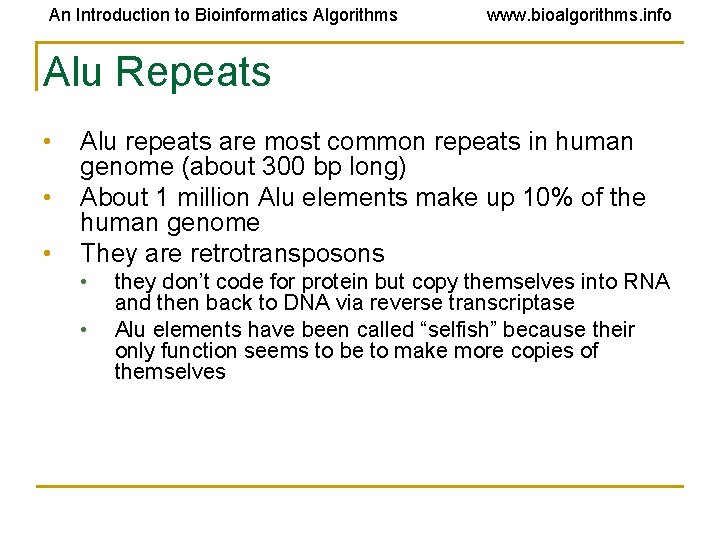
An Introduction to Bioinformatics Algorithms www. bioalgorithms. info Alu Repeats • • • Alu repeats are most common repeats in human genome (about 300 bp long) About 1 million Alu elements make up 10% of the human genome They are retrotransposons • • they don’t code for protein but copy themselves into RNA and then back to DNA via reverse transcriptase Alu elements have been called “selfish” because their only function seems to be to make more copies of themselves
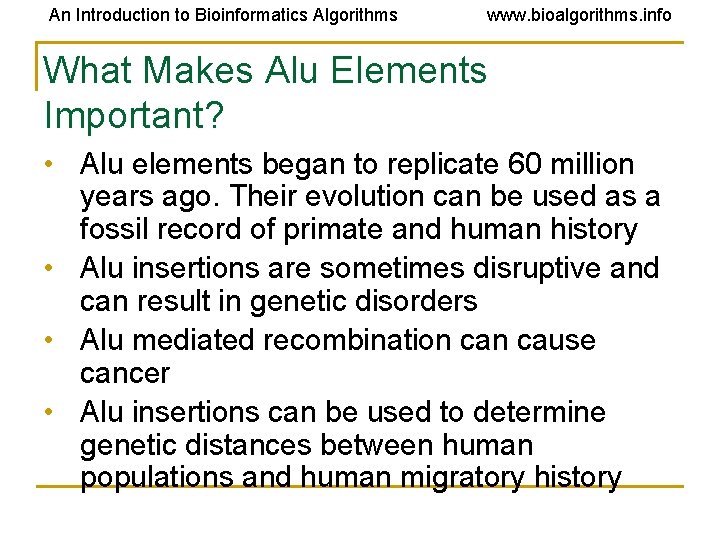
An Introduction to Bioinformatics Algorithms www. bioalgorithms. info What Makes Alu Elements Important? • Alu elements began to replicate 60 million years ago. Their evolution can be used as a fossil record of primate and human history • Alu insertions are sometimes disruptive and can result in genetic disorders • Alu mediated recombination cause cancer • Alu insertions can be used to determine genetic distances between human populations and human migratory history
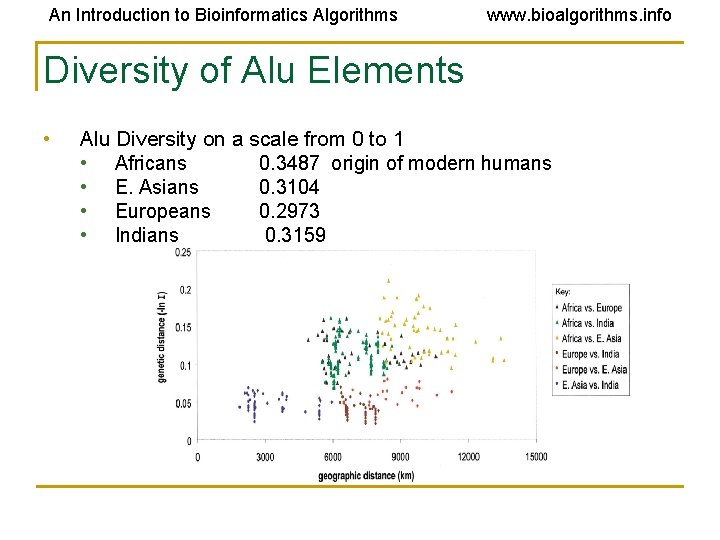
An Introduction to Bioinformatics Algorithms www. bioalgorithms. info Diversity of Alu Elements • Alu Diversity on a scale from 0 to 1 • Africans 0. 3487 origin of modern humans • E. Asians 0. 3104 • Europeans 0. 2973 • Indians 0. 3159
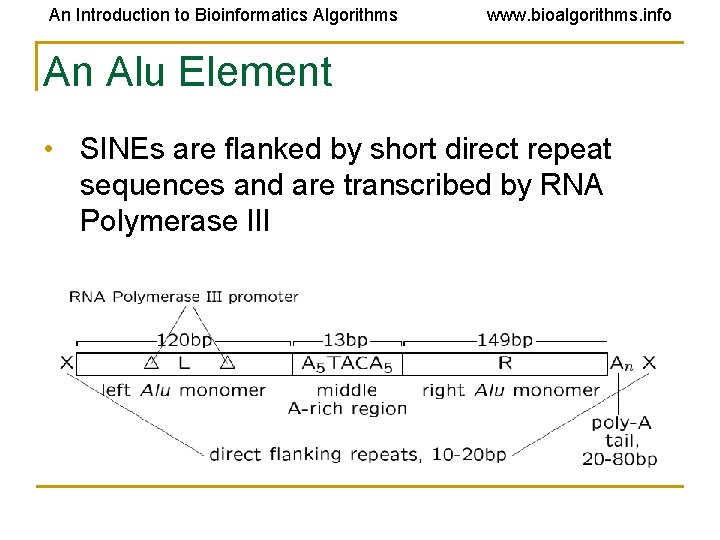
An Introduction to Bioinformatics Algorithms www. bioalgorithms. info An Alu Element • SINEs are flanked by short direct repeat sequences and are transcribed by RNA Polymerase III
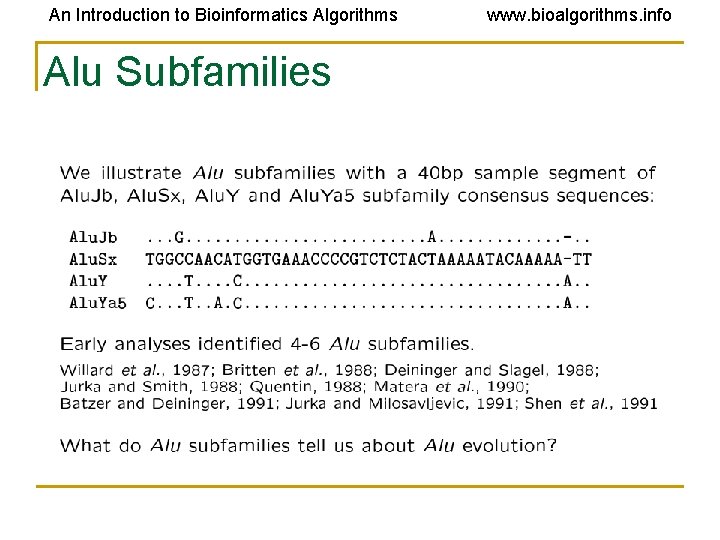
An Introduction to Bioinformatics Algorithms Alu Subfamilies www. bioalgorithms. info
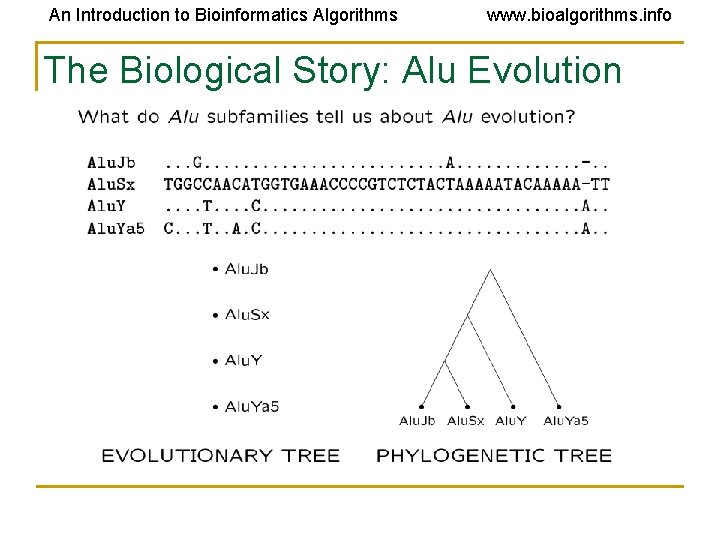
An Introduction to Bioinformatics Algorithms www. bioalgorithms. info The Biological Story: Alu Evolution
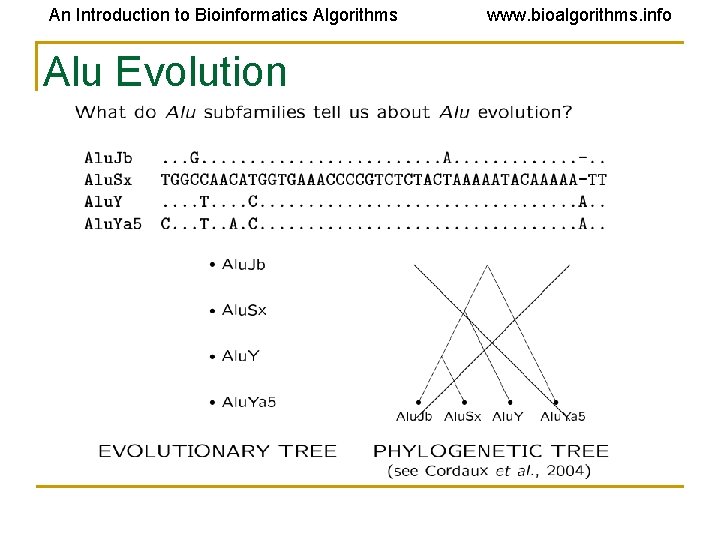
An Introduction to Bioinformatics Algorithms Alu Evolution www. bioalgorithms. info
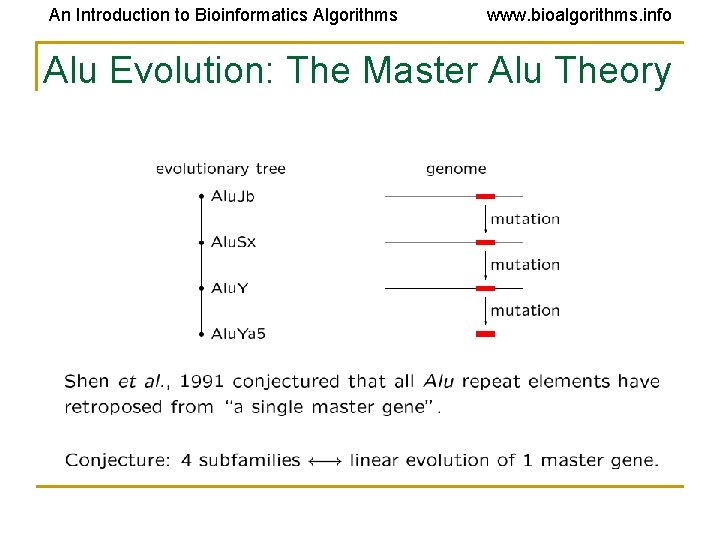
An Introduction to Bioinformatics Algorithms www. bioalgorithms. info Alu Evolution: The Master Alu Theory
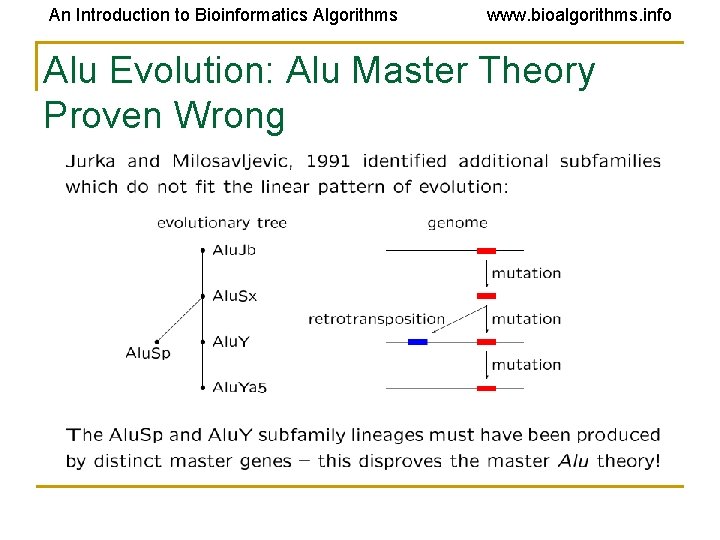
An Introduction to Bioinformatics Algorithms www. bioalgorithms. info Alu Evolution: Alu Master Theory Proven Wrong
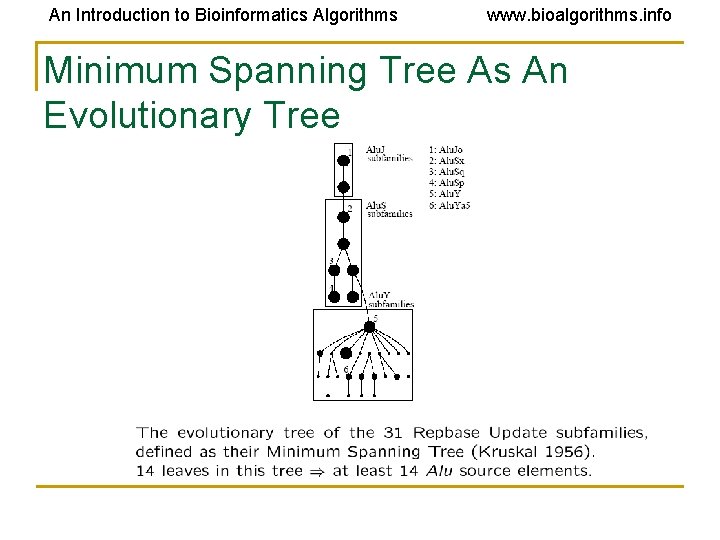
An Introduction to Bioinformatics Algorithms www. bioalgorithms. info Minimum Spanning Tree As An Evolutionary Tree
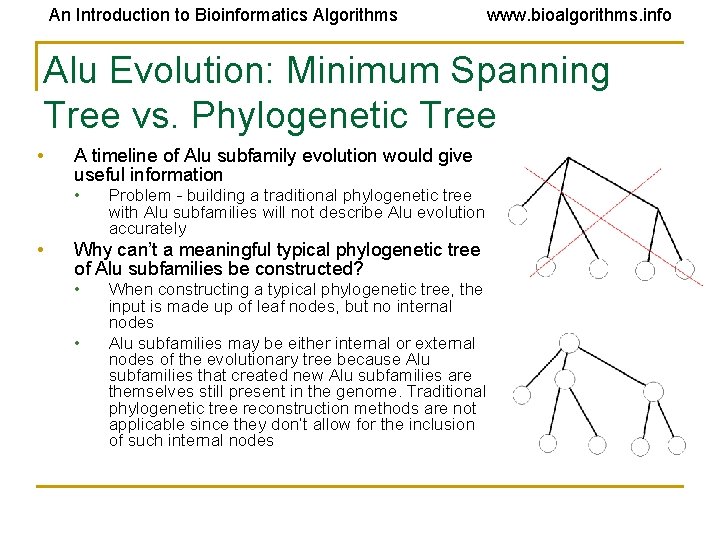
An Introduction to Bioinformatics Algorithms www. bioalgorithms. info Alu Evolution: Minimum Spanning Tree vs. Phylogenetic Tree • A timeline of Alu subfamily evolution would give useful information • • Problem - building a traditional phylogenetic tree with Alu subfamilies will not describe Alu evolution accurately Why can’t a meaningful typical phylogenetic tree of Alu subfamilies be constructed? • • When constructing a typical phylogenetic tree, the input is made up of leaf nodes, but no internal nodes Alu subfamilies may be either internal or external nodes of the evolutionary tree because Alu subfamilies that created new Alu subfamilies are themselves still present in the genome. Traditional phylogenetic tree reconstruction methods are not applicable since they don’t allow for the inclusion of such internal nodes
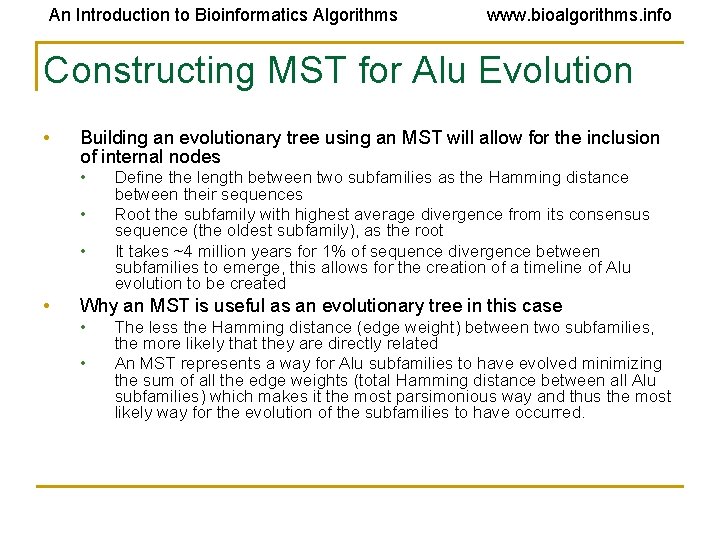
An Introduction to Bioinformatics Algorithms www. bioalgorithms. info Constructing MST for Alu Evolution • Building an evolutionary tree using an MST will allow for the inclusion of internal nodes • • Define the length between two subfamilies as the Hamming distance between their sequences Root the subfamily with highest average divergence from its consensus sequence (the oldest subfamily), as the root It takes ~4 million years for 1% of sequence divergence between subfamilies to emerge, this allows for the creation of a timeline of Alu evolution to be created Why an MST is useful as an evolutionary tree in this case • • The less the Hamming distance (edge weight) between two subfamilies, the more likely that they are directly related An MST represents a way for Alu subfamilies to have evolved minimizing the sum of all the edge weights (total Hamming distance between all Alu subfamilies) which makes it the most parsimonious way and thus the most likely way for the evolution of the subfamilies to have occurred.
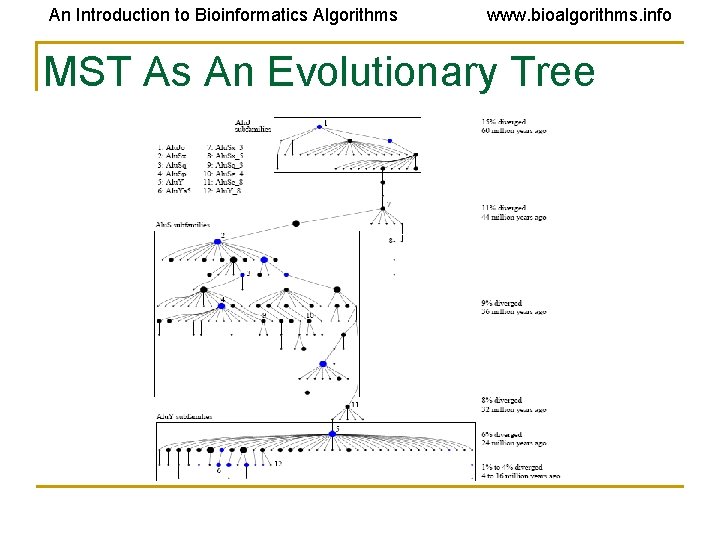
An Introduction to Bioinformatics Algorithms www. bioalgorithms. info MST As An Evolutionary Tree
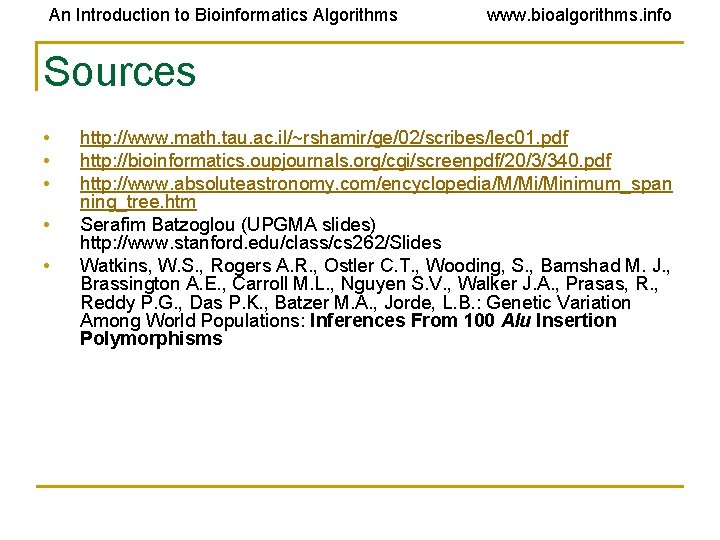
An Introduction to Bioinformatics Algorithms www. bioalgorithms. info Sources • • • http: //www. math. tau. ac. il/~rshamir/ge/02/scribes/lec 01. pdf http: //bioinformatics. oupjournals. org/cgi/screenpdf/20/3/340. pdf http: //www. absoluteastronomy. com/encyclopedia/M/Mi/Minimum_span ning_tree. htm Serafim Batzoglou (UPGMA slides) http: //www. stanford. edu/class/cs 262/Slides Watkins, W. S. , Rogers A. R. , Ostler C. T. , Wooding, S. , Bamshad M. J. , Brassington A. E. , Carroll M. L. , Nguyen S. V. , Walker J. A. , Prasas, R. , Reddy P. G. , Das P. K. , Batzer M. A. , Jorde, L. B. : Genetic Variation Among World Populations: Inferences From 100 Alu Insertion Polymorphisms
- Slides: 122